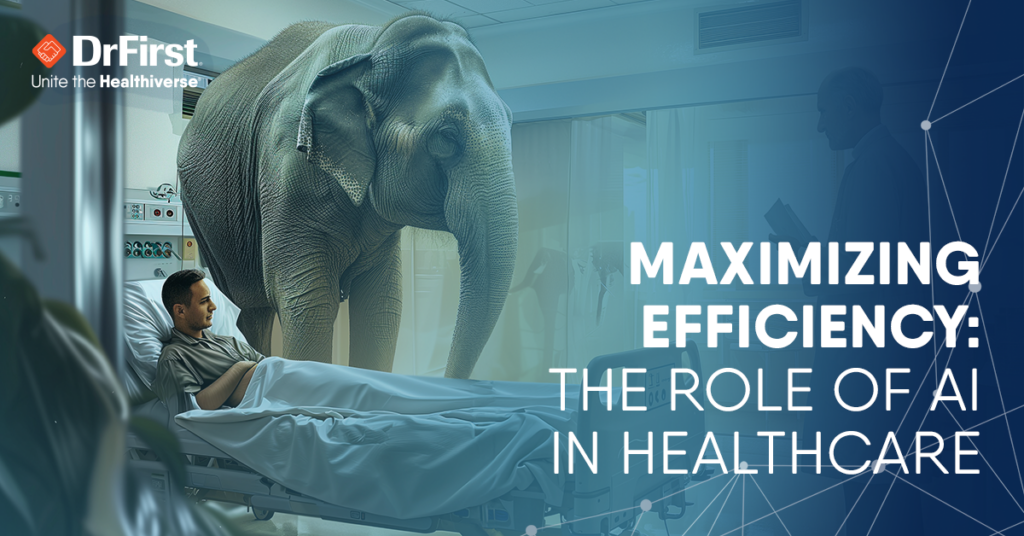DrFirst
Maximizing Efficiency: The Role of AI in Healthcare
See How Clinical-Grade AI is Making a Big Impact
Flanked by razor-sharp margins on one side and staffing shortages fueled by record-high clinician burnout on the other, hospital inefficiency is an elephant in the room; equal parts too great to ignore and too much to confront.
The magnitude of the problem is embodied in seemingly small details: repetitive, monotonous, manual clicks and keystrokes that waste time and create cognitive drain, contributing to staff dissatisfaction and risking patient safety. The growing sophistication of AI holds great promise in these areas because of its ability to streamline workflows in a way that frees clinicians from routine tasks, allowing them more time to engage in meaningful human interaction with their patients.
But great promise also brings possible danger: How can health systems embrace AI’s potential to improve efficiency without compromising safety?
AI With a Specific Purpose—and Solid Results
Since 2015, DrFirst’s AI has steadily improved the usability of medication data in incremental and significant ways. Long before generative AI and large language models were trending, we developed machine learning and AI for practical, high-volume healthcare applications—not pie-in-the-sky promises.
We define “AI” as “augmented intelligence,” a subset of artificial intelligence, because our solutions support and streamline clinicians’ decision-making rather than replace it. And we make a clear distinction between AI that’s used for general purposes and clinical-grade AI that has been trained on high-quality healthcare data, is validated by a team of clinical pharmacists, and complies with strict requirements for data security.
Clinical-grade AI multiplies the effectiveness of clinicians and staff with practical tools that make unstructured patient information automatically available in the electronic health record (EHR) system, giving clinicians quicker access with fewer clicks and keystrokes. Our medication management platform, Fuzion by DrFirst, puts clinical-grade AI to work in the role of co-pilot, translating unstructured text and safely inferring missing data, giving back precious time to clinicians for patient-facing care. The result is efficiency improvement on a scale that hospital executives are under enormous pressure to deliver:1
- Up to 93% translation of free text in patient medication instructions (“sigs”)
- 80% reduction in clicks and keystrokes
Strong Guardrails Protect Patients
Just as a dentist wouldn’t use a cordless drill intended for home repairs to prepare a cavity for a filling, a clinician wouldn’t depend on an unproven AI engine to inform patient care decisions. At DrFirst, our clinical-grade AI is trained and consistently monitored by pharmacists with high-quality, high-volume prescription data from more than 23 years of e-prescribing.
With carefully created guardrails, clinical-grade AI alerts staff if there isn’t enough information to safely determine clinical intent, preventing the mistakes that can be caused by biased or low-quality training data, a lack of context provided by the user, or insufficient programming.
5 Keys to Clinical-Grade AI
Trained on relevant data and updated frequently, clinical-grade AI automates the process of translating medication data into nomenclature that can be consumed by the receiving system, significantly reducing the risk of errors that lead to avoidable adverse drug events and reducing the manual burden that contributes to clinician burnout. Here are the five keys that differentiate clinical-grade AI from general, all-purpose generative AI:
Safe and reliable – Most generative AI engines aren’t smart enough to know what they don’t know. They give an answer for every query, even if it’s flat-out wrong. That’s not acceptable in healthcare, where patient safety is paramount. The guiding principle for our clinical-grade AI is that it’s better to provide no answer than to deliver a wrong answer. It infers missing data only when it’s safe to do so. If there’s any doubt about clinical meaning, the AI flags it for a clinician to make the call.
Clinically validated – Our team of licensed physicians and pharmacists continually verify accuracy and provide input using real-world transactions.
Transparent and explainable – We built and trained our clinical-grade AI with robust, real-world prescription data from NCPDP standard streams, using the data as well as the context in which that data resides. Together with our clinical and statistical guardrails, data context is an essential element of accuracy.
Interoperable – The main mission of our clinical-grade AI is to enable communication between disparate systems that don’t speak the same language. Where general AI engines create new information based on their training data, our AI determines clinical intent and translates the information into the precise terms the receiving system understands.
Secure and private data – More than 2,000 hospitals and health systems and 20,000 ambulatory facilities use DrFirst products. As an intelligent medication management company, we work almost exclusively with protected health information (PHI). We have it covered.
The precise details of medication management workflows may not produce headline-grabbing examples of AI success, but they can have a big impact on healthcare inefficiency at a time when health system leaders are confronting high demand, skyrocketing costs, and staffing shortages. By uncovering the medication data hidden in unstructured text, clinical-grade AI automates seemingly small data-entry transactions millions of times every day, delivering large payoffs in efficiency, staff satisfaction, and patient safety.

















